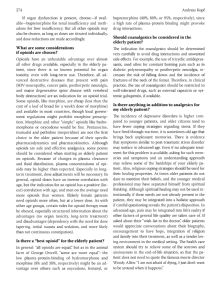Page 286 Guide to Pain Management in Low-Resource Settings
P. 286
274 Andreas Kopf
If organ dysfunction is present, choose—if avail- buprenorphine (40%, 80%, or 95%, respectively), since
able—buprenorphine for renal insuffi ciency and meth- a high rate of plasma-protein binding might provoke
adone for liver insuffi ciency. But all other opioids may drug interactions.
also be chosen, as long as doses are titrated individually,
and dose reductions are made accordingly. Should coanalgesics be considered in the
elderly patient?
What are some considerations Th e indication for coanalgesics should be determined
if opioids are chosen? very carefully to avoid drug interactions and unwanted
Opioids have an unbeatable advantage over almost side eff ects. For example, the use of tricyclic antidepres-
all other drugs available, especially in the elderly pa- sants, used often for constant burning pain such as in
tient, since there is no known potential for organ diabetic polyneuropathy or postherpetic neuralgia, in-
toxicity, even with long-term use. Th erefore, all ad- creases the risk of falling down and the incidence of
vanced destructive diseases that present with pain fractures of the neck of the femur. Th erefore, in clinical
(HIV-neuropathy, cancer pain, postherpetic neuralgia, practice, the use of coanalgesics should be restricted to
and major degenerative spine disease with vertebral well-tolerated drugs, such as external capsaicin or sys-
body destruction) are an indication for an opioid trial. temic gabapentin, if available.
Some opioids, like morphine, are cheap (less than the
Is there anything in addition to analgesics for
cost of a loaf of bread for a week’s dose of morphine)
my elderly patient?
and available in most countries, though local govern-
ment regulations might prohibit morphine prescrip- Th e incidence of depressive disorders is higher com-
tion. Morphine and other “simple” opioids like hydro- pared to younger patients, and older citizens tend to
morphone or oxycodone would be fi ne. Pentazocine, have fewer coping strategies regarding stress. If they
tramadol and pethidine (meperidine) are not the fi rst have lived through wartime, it is sometimes old age that
choice in the older patient because of their specifi c brings back unpleasant memories. Th ere is evidence
pharmacodynamics and pharmacokinetics. Although that symptoms similar to post-traumatic stress disorder
opioids are safe and eff ective analgesics, some points may surface in advanced age. Even if no adequate treat-
should be considered when starting an elderly patient ment for this problem is available, asking for such mem-
on opioids. Because of changes in plasma clearance ories and symptoms and an understanding approach
and fl uid distribution, plasma concentrations of opi- may relieve some of the hardships of your elderly pa-
oids may be higher than expected. Especially in long- tient. Also, religious coping strategies should be used for
term treatment, dose adjustments will be necessary. In their healing properties. At times older patients do not
general, opioid doses have an inverse correlation with dare to mention their beliefs, and the younger medical
age, but the indication for an opioid has a positive (lin- professional may have separated himself from spiritual
ear) correlation with age, and men on the average need thinking. Although spiritual healing may not be used in-
more opioids than women. Elderly female patients tentionally, if these needs are not already present in the
need opioids more often, but at a lower dose. As with patient, they may be integrated into a holistic approach
other age groups, certain rules for opioid therapy must if careful questioning reveals the patient’s disposition. In
be obeyed, especially structured information about the advanced age, pain may be integrated into life’s reality if
advantages (no organ toxicity, long-term treatment) other factors of general life quality are taken care of. If
and disadvantages (dependency with the need for dose asked about their “wish-list to the doctor,” older patients
tapering, initial nausea and sedation, and more likely would appreciate conversations about their biography,
than not continuous constipation). encouragement to have hope, integration of religion
and family into their treatment, as well as a tender lov-
Is there a “best opioid” for the elderly patient? ing environment in the medical setting. Th e health care
In general: “all opioids are equal,” but as in the animal system should try to relieve some of the sorrows and
farm of George Orwell, “some are more equal”: the anxiousness in the end-of-life situation, so that the pa-
low plasma-protein-binding of hydromorphone and tient does not need to quote the famous movie director
morphine (8% and 30%, respectively) might be an ad- Woody Allen: “I am not afraid of dying, I just don’t want
vantage over others such as oxycodone, fentanyl, or to be around when it happens.”


